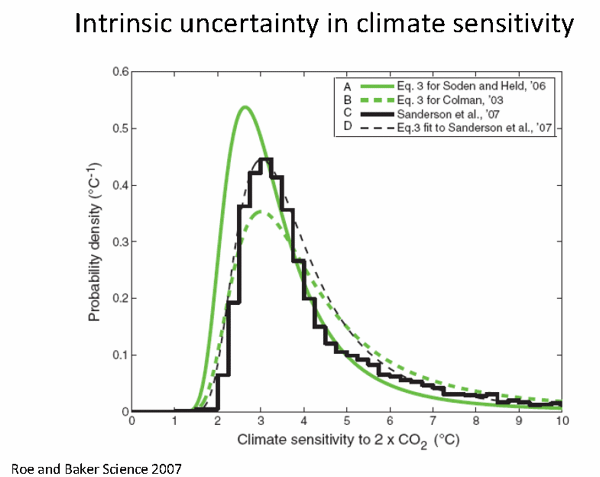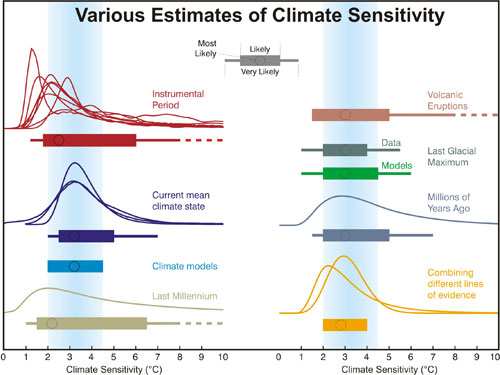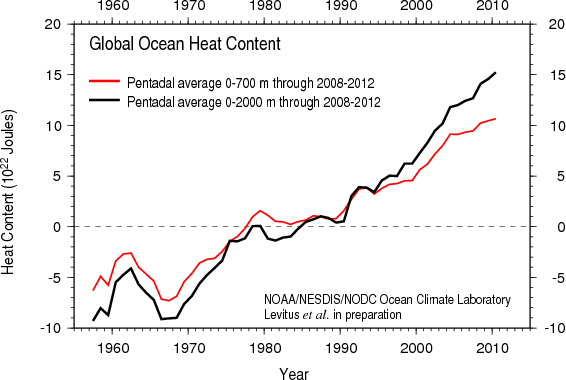What is the significance of climate sensitivity's long tail?
What the science says...
Recent studies concluding that climate sensitivity is unlikely to be very high (above 4°C global surface warming in response to doubled atmospheric CO2) are often fundamentally flawed because they ignore the accelerated warming of the deep oceans. However, these studies still agree that climate sensitivity is within the IPCC expected range.
No long tail means climate sensitivity is low
"this is what many have been saying now and for some time, that the climate sensitivity has been overestimated. Kudos to Annan for realizing the likelihood of a lower climate sensitivity" (Anthony Watts)
Comments by a few climate scientists that climate sensitivity (the total amount of global surface warming in response to the increased greenhouse effect from a doubling of atmospheric CO2, including amplifying and dampening effects) is unlikely to be very high have been widely misinterpreted. For example, in a blog post and in comments on Andrew Revkin's Dot Earth blog, climate scientist James Annan said:
"...a high climate sensitivity [is] increasingly untenable. A value (slightly) under 2 is certainly looking a whole lot more plausible than anything above 4.5."
Annan is mostly critical of the Intergovernmental Panel on Climate Change (IPCC) for maintaining the "long tail" of high possible climate sensitivity values, for example as shown in Figure 1.

Figure 1: Probability distribution of climate sensitivity to a doubling of atmospheric CO2, from Roe and Baker (2007)
Uncontroversial Comments
Annan's own work has focused on constraining the range of climate sensitivity values. For example, Annan and Hargreaves (2009) investigated the question using a Bayesian statistical approach, and concluded that
"the long fat tail that is characteristic of all recent estimates of climate sensitivity simply disappears, with an upper 95% probability limit ... easily shown to lie close to 4°C, and certainly well below 6°C."
Annan appears to feel that the IPCC has been too slow to let go of the sensitivity 'long tail' and incorporate a more tightly-constrained probability distribution into their reports. However, from a purely policy standpoint, it is important to consider all possible scenarios, and a very high climate sensitivity cannot yet be ruled out, as Chris Colose explains (via personal communication):
"From an IPCC/policy perspective, however, I'm not convinced the longer tails should be completely disregarded, even if they have very low probability of being consistent with the present-day evidence. Ray Pierrehumbert pointed to the Pliocene-case where a much different climate prevailed at a time with very similar climatic boundary conditions as present. The issue runs deeper than this, since such a regime shift could indicate the low-but-finite-probability of some sort of bifurcation point in the system ... I have seen this behavior in GCM's, not necessarily dor a doubling of CO2, but for higher concentrations, and as others have noted, the world doesn't end once we double CO2."
Nevertheless, in general, Annan's comments are consistent with the body of mainstream climate science research, and most of his colleagues believe that climate sensitivity is most likely close to 3°C surface warming in response to doubled CO2; unlikely to be more than 4.5°C or less than 2°C. One good example of this was Hansen et al. (2008), which concluded that equilibrium climate sensitivity is
"3 ± 1°C for the 4 W/m2 forcing of doubled CO2."
And the probable range of equilibrium climate sensitivity cited by Annan is fully consistent with the body of scientific literature (Figure 2).
Figure 2: Distributions and ranges for climate sensitivity from different lines of evidence. The circle indicates the most likely value. The thin colored bars indicate very likely value (more than 90% probability). The thicker colored bars indicate likely values (more than 66% probability). Dashed lines indicate no robust constraint on an upper bound. The IPCC likely range (2 to 4.5°C) is indicated by the vertical light blue bar. Adapted from Knutti and Hegerl (2008).
Really all Annan is disputing is the 'long tail' of possible climate sensitivity values above 4.5°C, which Annan believes are more improbable than the IPCC report has stated. Nevertheless, the 'long tail' represents very low probability scenarios even in the IPCC report.
Memo to Contrarians: "High" Isn't What You Think it is
It's something of a mystery why the climate contrarian blogosphere lit up in response to Annan's fairly mainstream, uncontroversial comments, other than the fact that he was rather critical of the IPCC. Annan said equilibrium climate sensitivity is unlikely to be higher than 4.5°C - there are few if any mainstream climate scientists who would disagree with this. He also said that sensitivity is unlikely to be much less than 2°C. This rules out the beliefs of many prominent climate scientist contrarians, like Roy Spencer (who believes equilibrium sensitivity is around 1.3°C) and Richard Lindzen (who believes it's less than 1°C).
In short, the comments Annan made which were celebrated by climate contrarians are incompatible with the beliefs of the most prominent climate contrarian scientists, but entirely compatible with mainstream climate scientists like James Hansen. Is this really an argument you want to get behind, contrarians?
Another issue highlighted by Joe Romm – climate sensitivity is not the same thing as future projected warming, unless we limit ourselves to a doubling of atmospheric CO2. At the moment, our emissions are tracking along some of the worst case scenarios (Figure 3), and if this continues, we will blow well past a doubling of atmospheric CO2.
Figure 3: IEA fossil fuel CO2 emissions estimates vs. IPCC SRES emissions scenarios.
This highlights a mistake that climate contrarians make frequently, for example claiming that we will only see 1°C warming over the next century. The amount of future warming depends on two factors - climate sensitivity, and human CO2 emissions. Even if climate sensitivity is on the lower end, if we don't get our emissions under control, we will still see a dangerous amount of global warming (more details on this to come in a future blog post).
Do We Have "A Bit More Time"?
Annan has also made the case that the most likely equilibrium climate sensitivity value may be closer to 2.5°C than 3°C. This case appears to be based on recent research taking two different approaches: looking at recent climate changes, and changes during the Last Glacial Maximum (LGM) about 20,000 years ago. As with the press release and media attention surrounding the Norwegian climate sensitivity project we recently examined, this has resulted in some suggestions that perhaps climate sensitivity is toward the lower end of possible values, which might buy us a bit more time to reduce human greenhouse gas emissions.
If true this would be good news, because our current efforts to reduce global human CO2 emissions have been woefully inadequte. They continue to climb with no international climate agreement in sight.
However, caution is advisable here. As we discussed regarding the Norwegian paper, studies estimating climate sensitivity based on recent data may be biased low due to a failure to account for increased heat transfer to the 700–2000 meter ocean layer (Figure 3).
Figure 3: Comparison of Global Heat Content 0-700 meters layer vs. 0-2000 meters layer, from the National Oceanographic Data Center.
Kevin Trenberth similarly notes (via personal communication),
"Global surface temperature is but one manifestation of warming and not a very good one as it is subject to a lot of natural variability. The increasing evidence for much more heat going deeper into the ocean has major implications and that pattern can easily be reversed. I think that any assessment of climate sensitivity based on the short term temperatures record is fraught with major difficulties and the implied assumptions do not stand up. Simple box models that keep mixing into deep ocean fixed are wrong!
Another interpretation is that given a certain energy imbalance at the top of atmosphere, if the heat is not manifested as surface temperature rise then it goes elsewhere. Another place it goes is into the more vigorous hydrological cycle which has a whole new set of implications."
There are also significant uncertainties associated with some radiative forcings (aerosols in particular), and the possibility that climate feedbacks are not linear (e.g. discussed in Long and Collins 2013).
As for the LGM, equilibrium climate sensitivity estimates depend strongly on the temperature data used. Research by Schmittner et al. (2011) and Annan and Hargreaves (2012) found most likely equilibrium sensitivity values close to 2.5°C based on LGM changes, whereas as noted above, Hansen et al. (2008) estimated 3 ± 1°C sensitivity based on the LGM. The Schmittner and Annan studies used ocean temperature data from the Multiproxy Approach for the Reconstruction of the Glacial Ocean (MARGO) project, about which Richard Alley noted:
"MARGO made a solid effort, which indicates very small temperature changes. But, there are other ways to do it, and indeed, [Schmittner et al.] coauthor Alan Mix has published independent papers indicating that the temperature changes were larger in some regions than indicated by MARGO. David Lea and others have also obtained larger temperature shifts….
In short, the MARGO data for the ocean show very small temperature change from the ice age to today, and thus lead to the low climate sensitivity, but they disagree with some independent estimates showing larger temperature change. They also lead to disagreement with the pollen-based land temperature data. Furthermore, they lead to an answer that disagrees with many other lines of evidence for climate sensitivity."
A smaller temperature change estimate will result in a lower climate sensitivity estimate, so if MARGO data are biased low, that could result in a too-low climate sensitivity estimate.
Nevertheless, 2.5°C equilibrium sensitivity is certainly a possibility, well within the IPCC range. And it would essentially give us an extra 10 to 15 years of greenhouse gas emissions before we become committed to 2°C warming above pre-industrial levels, for example – in roughly 2038 as opposed to 2027 in Representative Concentrations Pathway (RCP) 4.5, which represents a scenario in which we slowly reduce our greenhouse gas emissions. This also depends on how our aerosol and soot emissions change in the future.
Realism is Important
Ultimately while 2.5°C equilibrium sensitivity would certainly be better news than 3°C, it's not something we can bank on. In either scenario we need to take serious action to reduce human greenhouse gas emissions in order to avoid dangerous and potentially catastrophic climate change.
James Annan's comments and research are also incompatible with an equilibrium climate sensitivity much less than that – certainly nowhere near as low as the most prominent climate contrarians would have us believe.
The danger with acting as though we have plenty of time to reduce our emissions is that if this turns out not to be the case, we may find ourselves beyond the point where potentially catastrophic climate change is avoidable. At the moment, the body of scientific research points to 3°C as the most likely equilibrium climate sensitivity value. It's possible that it's 2.5°C, or even 2°C, but there's also evidence that it may be closer to 4°C, and it's certainly not much below 2°C, contrary to contrarian beliefs. In any realistic scenario, we need to take serious and immediate action to reduce human greenhouse gas emissions.
Hopefully sensitivity is on the lower end of possible values, but in any case, we are running out of time to solve the problem. We will have a blog post examining the various possible climate change scenarios (from best case to worst case) in the near future.
Last updated on 24 March 2013 by dana1981. View Archives































 Arguments
Arguments































Climate Myth...